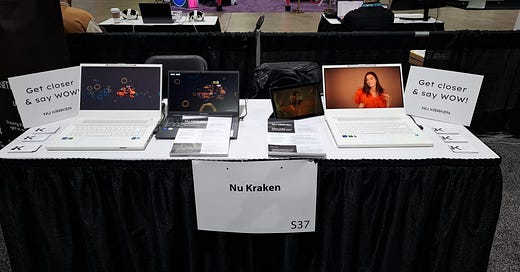Last week, I had the opportunity to attend Augmented World Expo (AWE) 2025 at the Long Beach Convention Center. It was a fantastic experience—reconnecting with friends, meeting new people, and returning to California (always a pleasure). It was also my debut at AWE under the Nu Kraken banner, which marks a milestone for us.
The Good
1. The Industry Keeps Pushing Forward
We were stationed near the Nexus Stage, where countless pitches and presentations took place. What struck me was the sheer volume of ideas being shared. Some were good, some didn’t seem so, but still proof that the immersive tech space is still buzzing with experimentation, research, and belief in what’s possible. Despite the challenges, people are still trying, still searching for the next breakthrough. That optimism was contagious.
2. The Power of Face-to-Face Interaction
In an increasingly digital world, there’s something irreplaceable about real human connection. Video calls have their place, but discussing ideas in person adds layers of nuance: body language, spontaneous reactions, and the kind of unfiltered feedback that only happens when someone is standing right in front of you.
With over 5,000 attendees roaming the expo, I was constantly challenged by tough questions, unexpected perspectives, or just the sheer diversity of thought. Many companies (and executives) focus on media coverage or landing clients at these events. These are great, but the success depends on external factors. However, observing how people interact with your product and take notes on the result is all in your hands. Studying their reactions, hesitations, and "aha" moments are invaluable… if you’re willing to listen.
3. Long Beach: A Pleasant Surprise
Though I’ve been to Los Angeles many times, this was my first visit to Long Beach, and I was impressed. The area around the convention center felt vibrant, full of energy and creativity. It was refreshing to see a community so alive with movement and innovation.
The Bad (or at Least, the Challenging)
1. XR Still Feels Niche
Despite the enthusiasm, immersive tech hasn’t yet found its killer app or use case for the masses. Many solutions cater to enterprise needs, but where’s the must-have consumer use case? Some will disagree, but I’m not convinced we’ve found a reason for XR that can’t be done (or done better) in 2D.
Yes, real 3D is cool, like really cool, but so are high-fidelity graphics, and right now, many XR experiences still feel like cheap 3D rather than something truly transformative.
Let’s not forget: XR requires adoption hurdles: whether it’s wearing bulky headsets, investing in AR glasses, or paying a premium for spatial displays1. Being slightly better, cooler, or novel isn’t enough. The value proposition must be undeniable
2. The UI Problem in XR
I saw multiple attempts to reinvent UI for 3D spaces, and while I agree that floating 2D panels aren’t ideal, the proposed alternatives didn’t feel like clear improvements.
Here’s the thing: Even in a 3D world, 2D UI works because it’s familiar. Buttons, scrollbars, menus, they’re intuitive. We’ve been using them for half a century!2. Any true 3D UI must offer clear, immediate value to justify the learning curve. Current research shows that 3D navigation is easier with 3D input, but how do we design interfaces that feel as natural as tapping a touchscreen? That’s a hard problem, and we’re not there yet.
3. Is the US Losing Its Global Appeal for Conferences?
In the past, US events like AWE felt like must-attend global gatherings. This year, though, I noticed far fewer European colleagues making the trip, likely due to travel advisories and political concerns.
I won’t dive into politics here, but as someone who has always felt welcomed in the US (from executives to service workers), it’s frustrating to think that external perceptions might keep people away. The US has so much to offer: its people, its innovation hubs, its culture… and it’d be a shame if that became overshadowed.
A Bonus Experience: Visiting Disney Studios
As a side trip, I had the incredible opportunity to visit Walt Disney Studios in Burbank. Walking through the historic lots where iconic stories were crafted was surreal, but it also made me reflect on something deeper.
Remote work has its perks, but there’s undeniable value in physical spaces that carry decades (or centuries) of legacy. For seasoned professionals, maybe location doesn’t matter as much because they already know the craft. But for junior talent, being disconnected from the environment where ideas are born, where collaboration happens spontaneously, might be a real loss.
More on that thought later because I think it’s worth exploring further.
Final Thoughts
AWE 2025 was a reminder of both the excitement and the hurdles in XR. The industry is moving, but where exactly? That’s still unclear. What is clear is that human connection, whether at a conference or in a historic studio, still matters. Maybe more than ever.
Which is another name for autostereoscopic displays, or glasses-free 3D displays. Companies like Acer and Sony are actively pushing for that name to stick.
The Xerox Alto was a computer system considered one of the first workstations or personal computers. It featured a graphical user interface (GUI) already in 1973.




